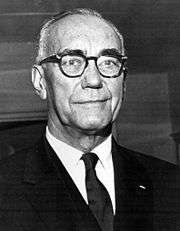William Henry Draper Jr.
| William Henry Draper Jr. | |
|---|---|
|
U.S. army officer, banker, and diplomat | |
| Born |
August 10, 1894 Harlem, Manhattan, New York, United States |
| Died | December 26, 1974 (aged 80) |
| Spouse(s) | Katherine Louise Baum |
William Henry Draper Jr. (August 10, 1894 – December 26, 1974) was a U.S. army officer, banker, and diplomat.
Early life
Draper was born in Harlem, New York City, the son of Mary Emma (née Carey; 1872–1960) and William Henry Draper (1859–1929). He received a B.A. and M.A. in economics at New York University. He joined the US Army soon after finishing college and served during World War I as a major in the infantry.
Career
After the war, he stayed in the Army Reserves and worked his way up to chief of staff of the 77th Division (1936–1940). He worked in New York City for National City Bank (1919–1921), Bankers Trust Company (1923–1927), and then Dillon, Read & Co. (1927–1953). In 1937, he was made a vice president of Dillon Read, an investment bank that had promoted the bonds of the Soviet Union after its recognition by the US government in 1933. Dillon Read also underwrote millions of dollars worth of German industrial bonds in the United States in the 1920s and 1930s.[1]
At the invitation of George Marshall, he moved to Washington, D.C., to serve on the President's Advisory Committee for Selective Service, and he was promoted to colonel in 1940. At the start of World War II, he took command of the 136th Infantry, 33rd Division, National Guard.
At the end of the war, he was promoted to brigadier-general and was posted to Berlin to serve as chief of the Economics Division, Allied Control Council for Germany from 1945 to 1947. He opposed the Morgenthau Plan, which was designed to prevent a resurgence of German economic and military power by deindustrializing it and turning into a pastoral country. Instead, he strongly supported measures to expedite Germany's economic recovery along liberal free-market and democratic lines followed by Konrad Adenauer and Ludwig Erhard. There was some criticism of him by the Chief of the Decartelization Branch for Military Government in Germany after World War II, James Stewart Martin for leaving some former Nazis in their positions in industry.[2]
After a promotion to major-general, Draper was asked by the new Secretary of War Kenneth C. Royall to become his Under Secretary of War. With the transition of the Department of War to the Department of the Army, Draper became the first under secretary of the Army from September 18, 1947 to February 28, 1949.[3]
After leaving the army in 1949, he served as Long Island Rail Road trustee from 1950 to 1951. He served as the first US Ambassador to NATO in Paris.
After retiring from public service a second time, he traveled to Mexico to serve as chairman of the Mexican Light and Power Company. Returning to the US in 1959, he formed the first West Coast venture capital firm Draper, Gaither and Anderson in California. In 1967, he retired from Draper Gaither, moved to Washington, D.C. and joined Combustion Engineering in New York as chairman, retiring a few years later to become the US delegate to the United Nations Population Commission (1969-1971). He also cofounded the Population Crisis Committee in 1965 and chaired the Draper Committee.
See also
- William Henry Draper III is his son and founder of Sutter Hill Ventures.
- Polly Draper is his granddaughter, an actress and a writer, most known for her portrayal on ABC's Thirtysomething. She also created and produced Nickelodeon's The Naked Brothers Band, which starred her sons Nat Wolff and Alex Wolff.
- Timothy C. Draper is his grandson, a venture capitalist who founded Draper Fisher Jurvetson.
References
- ↑ White, Theodore H. "No. 1 American in Europe." The New York Times Magazine 21 December 1952. Print.
- ↑ James Stewart Martin (1950). All Honorable Men: The Story of the Men on Both Sides of the Atlantic Who Successfully Thwarted Plans to Dismantle the Nazi Cartel System. Little, Brown and Company. ASIN B0000EEKBR. Retrieved 17 September 2010.
- ↑ White, Theodore H. "No. 1 American in Europe." The New York Times Magazine 21 December 1952. Print.
External links
- Oral History Interview with General William H. Draper Jr.
- Time Magazine Topside Teammates January 28, 1952
| Political offices | ||
|---|---|---|
| Preceded by New Office |
United States Under Secretary of the Army 18 September 1947 – 28 February 1949 |
Succeeded by Gordon Gray |
| Preceded by Kenneth Royall |
United States Under Secretary of War 29 August 1947 – 17 September 1947 |
Succeeded by Himself as United States Under Secretary of the Army |
| Business positions | ||
| Preceded by David E. Smucker and H.L. Delatour |
President of Long Island Rail Road 1950–1951 |
Succeeded by William Wyer |


